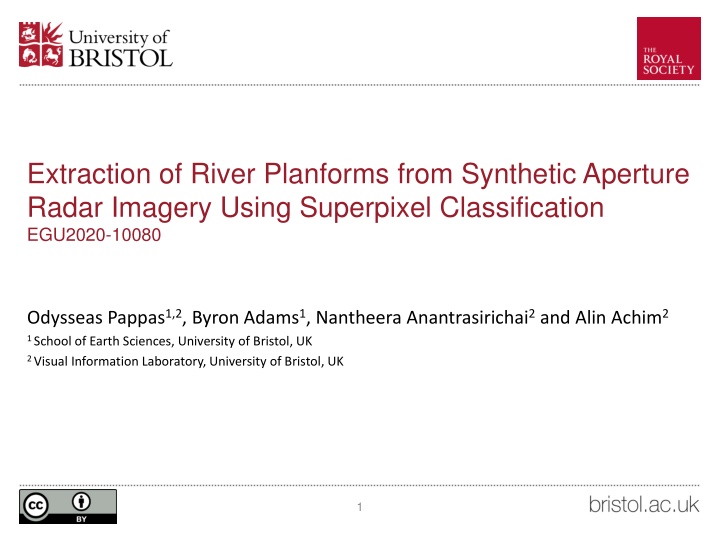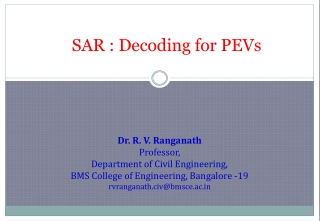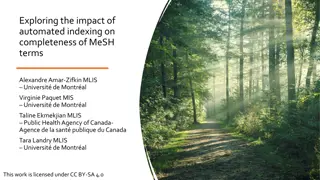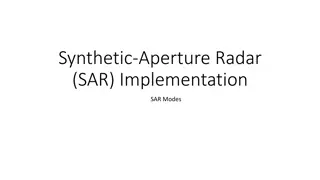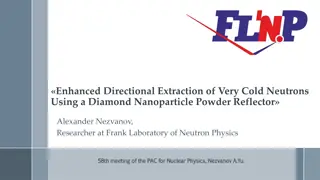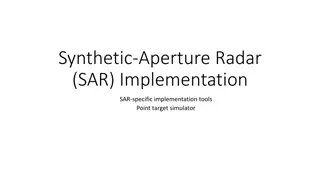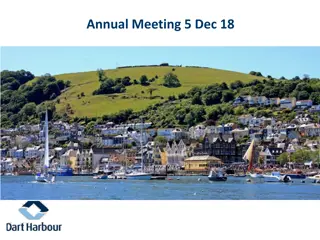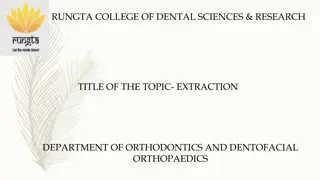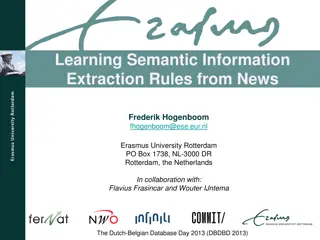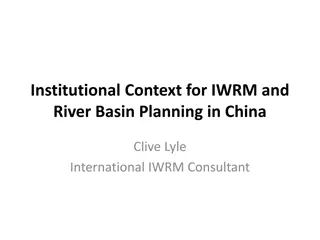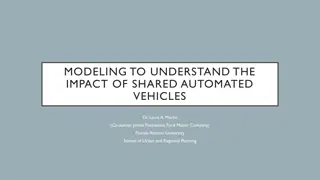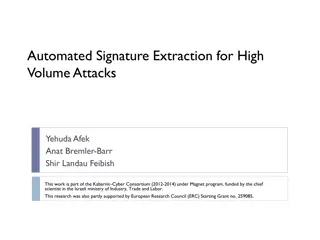Automated River Planform Extraction from SAR Imagery Using Superpixel Classification
River monitoring for environmental applications relies on remote sensing data. This study proposes a superpixel-based approach to segment river planforms from SAR imagery, addressing challenges such as noise and lack of spectral information.
Download Presentation

Please find below an Image/Link to download the presentation.
The content on the website is provided AS IS for your information and personal use only. It may not be sold, licensed, or shared on other websites without obtaining consent from the author.If you encounter any issues during the download, it is possible that the publisher has removed the file from their server.
You are allowed to download the files provided on this website for personal or commercial use, subject to the condition that they are used lawfully. All files are the property of their respective owners.
The content on the website is provided AS IS for your information and personal use only. It may not be sold, licensed, or shared on other websites without obtaining consent from the author.
E N D
Presentation Transcript
Extraction of River Planforms from Synthetic Aperture Radar Imagery Using Superpixel Classification EGU2020-10080 Odysseas Pappas1,2, Byron Adams1, Nantheera Anantrasirichai2and Alin Achim2 1 School of Earth Sciences, University of Bristol, UK 2 Visual Information Laboratory, University of Bristol, UK 1
Introduction River monitoring is crucial to a number of environmental applications such as landscape evolution, flood monitoring and forecasting and water resource management. The ever-increasing capability and availability of remote sensing data provides a promising alternative to in-situ manual monitoring. This necessitates the development of automated image processing tools for analysing and interpreting remotely sensed data for large-scale monitoring applications such as river monitoring. 2
Synthetic Aperture Radar - Challenges and Opportunities SAR is capable of producing images of high spatial resolution and is particularly sensitive to surface roughness. It is not limited by the day/night cycle and can produce images regardless of adverse meteorological conditions such as cloud cover. However, SAR images suffer from significant speckle noise. Standard SAR products provide no spectral/colour information that could be directly used to identify water pixels as in the case of multispectral data. 3
Our proposed approach Our proposed approach begins with a superpixel segmentation of the SAR image. This is done with a novel segmentation algorithm that models the image using a finite mixture model incorporating the Generalised Gamma distribution as a model for the SAR image values. The generated superpixels are characterised according to their statistics and texture to identify those that comprise the river. Agglomerative clustering is used to cluster these superpixels into a river planform, while connected component analysis can then be used to rid of false positives and to enforce connectivity. 4
Superpixels an introduction Superpixel algorithms aim to segment an image into homogeneous puzzle pieces (clusters of perceptually similar pixels) Superpixels aim to adhere to the edges of objects in the image and tend to be of similar size and shape They can serve as a perceptually meaningful prior for further image processing tasks or as an alternative to classical sliding window neighbourhoods. Right: Example of SLIC1 superpixel segmentation at 3 different levels of granularity (superpixel size). 5
SAR-Specific Superpixels Superpixel algorithms often operate as iterative clustering process that utilise some similarity metric between pixels. Most superpixel algorithms (e.g. SLIC) are designed with standard optical images in mind and make use of a pixel s colour information in such metrics. They are therefore at best sub-optimal for dealing with single-channel SAR images which lack colour information and whose noise characteristics are different. This necessitates superpixel algorithms specific to SAR images one of these is MISP2, which serves as the basis of our proposed superpixel algorithm. 6
Mixture Model Superpixels The mixture model superpixel algorithm (MISP)2 performs segmentation based on a finite mixture model which takes a SAR image pixel s amplitude and spatial coordinates as the features to be modelled. Pixels belonging to the same superpixels are assumed to be generated from the same mixture component. An iterative process assigns each pixel with the appropriate superpixel label and infers the parameters for the mixture model. Amplitudes are modelled as Nakagami distributed while spatial coordinates are bivariate Gaussian. 7
Generalised Gamma Mixture Model Superpixels We propose instead to model the amplitudes/intensities of the SAR image by the Generalised Gamma distribution, as it is an established state-of-the-art model that can better capture the heavy-tailed nature of modern SAR data3. |?|?? ? (?) ?? 1 ? ? ? ? ? ? ? = ??? ? ,x Where vis the distribution s power parameter controlling tail behaviour, and are the shape and scale parameters and ( ) is the Gamma function. The Nakagami and other distributions often used in SAR modelling like the Weibull and the Rayleigh arise as special cases of the GGD. 8
MISP-GGD Results Examples of superpixel segmentation on ICEYE-X2 SAR image. From left to right: Original scene, SLIC, MISP and MISP-GGD superpixel maps. 9
MISP-GGD Results Detail of previous figure. Left: Original MISP algorithm, right: MISP-GGD. Note the difference in boundary adherence on the river banks. 10
Superpixel Classification River superpixels differ from land cover superpixels in both their radiometric response and their texture. Radiometric differences can be quantified using statistical measures such as the sample median or the GGD . Textural differences can be quantified using entropy, Gray Level Co- occurrence Matrix features etc. Filters used for detecting longitudinal curvilinear structures, such as Gabor filter banks or the Multiscale Singularity Index can also be employed on a response per superpixel basis. 11
ICEYE-X2 River Masks Example of the river planform extraction method. Left: ICEYE-X2 SAR image (detail), Middle: MISP-GGD segmentation, Right: River mask comprised of superpixels agglomeratively clustered according to sample median, GGD , information entropy and MSI response. 12
SENTINEL-1 River Masks Example of the river planform extraction method. From left to right: SENTINEL SAR image (detail), MISP-GGD segmentation, River mask comprised of superpixels agglomeratively clustered according to sample median, GGD , information entropy and MSI response, River mask after removal of false positives based on connected component eccentricity. 13
Conclusions and Future Work We aim to expand on this body of work in future by further enhancing the accuracy of the generated river planform masks and by incorporating more elaborate heuristic methods for the identification of river channels and the removal of false positives, making for example the algorithm more capable of handling the presence of bridges. We also aim to focus on providing methods for reliably extracting measurements such as river widths and centerlines from the river masks; we hope to make a toolbox providing such functionality available in the near future. The work shown here is described in more detail in a journal paper titled River Planform Extraction From High-Resolution SAR Images Via Generalised Gamma Distribution Superpixel Classificatio submitted to the IEEE Transactions on Geoscience and Remote Sensing (currently undergoing revisions). 14
SAR Data Details ICEYE-X2: VV-polarised Stripmap product (Level 1B, Ground Range Detected, Orthorectified, Intensity image), spatial resolution of 3m. Multilooked with 3 looks in the azimuth and 2 in the range direction. The image shows part of the C Chi n River and its tributaries near thecity of Tr Vingh, Vietnam and was acquired on March 1st, 2019. SENTINEL-1: VH-polarised Interferometric Wide-Swath (IW) product (Level 1, Ground Range Detected, Amplitude image), spatial resolution of 10m. Multilooked with 1 look in the azimuth and 5 in the range direction. The image shows part of the Moselle river north of Metz, France and was acquired on October 27th, 2019. 15
Related References [1] R. Achanta, A. Shaji, K. Smith, A. Lucchi, P. Fua, and S. S sstrunk, SLIC Superpixels Compared to State-of-the-art Superpixel Methods , IEEE Transactions on Pattern Analysis and Machine Intelligence, vol. 34, num. 11, p. 2274 - 2282, May 2012. [2] S. Arisoy and K. Kayabol, Mixture-Based Superpixel Segmentation and Classification of SAR Images , IEEE Geoscience and Remote Sensing Letters, vol. 13, no. 11, pp.1721-1725, 2016. [3] H. Li, W. Hong, Y. Wu, and P. Fan, On the Empirical-Statistical Modeling of SAR Images With Generalized Gamma Distribution , IEEE Journal of Selected Topics in Signal Processing, vol. 5, no. 3, pp. 386 397, 2011. 16
Acknowledgments This research was supported by a Royal Society Dorothy Hodgkin Fellowship (DHF- R1-180068) and a Royal Society Enhancement Award (RGF-EA-182086) to B. A. Adams, by the Engineering and Physical Sciences Research Council (EPSRC) under grant EP/R009260/1 (AssenSAR) and by a Leverhulme Trust Research Fellowship (RF-2019-282/9) to A. Achim. 17
Abstract Algorithms for the detection and extraction of river planforms from remotely sensed images are of great interest to numerous applications including land planning, water resource monitoring, and flood prediction. Synthetic Aperture Radar (SAR) is a very promising modality for river monitoring and analysis as it can provide high resolution imagery regardless of weather conditions and the day/night cycle. In this work we present an algorithm for the detection and segmentation of rivers in SAR images, with emphasis on accurate riverbank extraction. The algorithm utilises a novel superpixel segmentation algorithm that segments the image into perceptually uniform clusters of pixels based on a modelling of the SAR data with the Generalised Gamma Distribution. The generated superpixels adhere to the edges of objects in the image (such as riverbanks) with great accuracy. Superpixels are then characterised according to several features that describe their statistical and textural properties which allows for the discrimination between river- and land-cover superpixels. The river-forming superpixels are then grouped together using unsupervised agglomerative clustering to produce river planform masks. We demonstrate our proposed method on high resolution SAR images from the SENTINEL-1 and ICEYE platforms. Future work will focus on incorporating more complex heuristics for the identification of false positives and to circumvent apparent river discontinuities (e.g. bridges), as well as on the release of a toolbox providing open access to the geosciences community. 18
